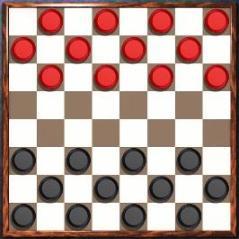Checkers
 There are many interesting stories about Checkers.
There are many interesting stories about Checkers.Background
Checkers has always suffered from a bit of an image problem. It's a medieval offspring of Chess, and it had to grow up in the shadow of its parent, which was at the time wildly popular. And it took several centuries to find the right balance in the rules. Many people look upon Checkers as that game you play until you're ready to learn Chess, but this attitude is mistaken. Checkers is a game with its own depths and complexities. A supercomputer brought down the human champion in Chess (IBM's Deep Blue, 1997); it took a supercomputer just to earn a tie with the human champion in Checkers (the University of Alberta's Chinook, 1994).
The French Mix and Match
Checkers is almost certainly a French invention of about the 12th century. It's a mixture of an old Moorish game, Alquerque (pronounced like the city of Albuquerque, minus the third and fourth letters), and Chess. Alquerque is the Spanish corruption of the Arabic el-quirkat. The game was first mentioned in print in a Moorish book published in the 10th century, but its history goes much farther back. One of the ancient temples of Egypt has an Alquerque board engraved in its roof. (Since we know the ancient Egyptians didn't float in midair, we can assume that this board was meant as a decoration. The Egyptians must have loved their games to have used them in this fashion.)
Alquerque gave Checkers the 12-man army and the capture-by-jumping concept. Alquerque is played on a latticed board, but the pieces occupy the intersections of the lines rather than the insides of the squares formed by the lines.
Chess provided the concept of the checkered board (a European innovation). When the French combined Chess and Alquerque, the Alquerque men moved off the intersections and occupied the Chess squares. Now all the new game needed was a name. Surprisingly, that too came from Chess.
When Chess came to Europe, it had no queen; instead, a piece called the fers (a Persian word meaning "counselor") stood beside the King. Because the pieces in Checkers moved like the Fers in Chess, the game was called Ferses, and the pieces, rather than the 12 flat disks we're familiar with, were 12 Ferses pilfered from Chess sets.By the year 1500, the Europeans had replaced the Fers in Chess with the queen—in French, the dame. The queen also knocked the Fers off the checkerboard. (So now the French were using 12 queens per army—and when a queen reached the last rank, it underwent a sex change and became a King. Interesting.) For the next 200 years the French referred to Checkers as Dames, a name that followed the game as it spread across the continent, from Turkey (Dama) to Scotland (where it is still referred to as Dams). In England, however, the game was called Draughts (pronounced Drafts), a Middle English word referring to a move made by the queen in Chess. Draughts is the name the English have continued to use; the pieces are the draughtsmen and the board is the draughtsboard.
Next: More interesting stories about Checkers..... how the word Checkers enters the language?



















2 Comments:
i want to find out the meaning of king me in the game of checkers
Please check on my post on October 25, 2005. "How To Play Checkers?"
Thank you!
Post a Comment
<< Home